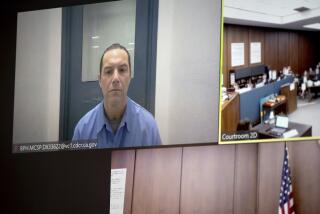Scent Evidence Barred in Retrial
- Share via
Dealing a blow to the prosecution in a controversial murder case, a judge ruled Friday that evidence from a bloodhound and a so-called scent machine cannot be presented in a retrial of Earl Rhoney.
Rhoney, 21, was convicted in 1996 of the murder of Patricia Lea Pratt, 46, and the burglary of her home in Irvine’s Turtle Rock community. He was the first person in California to be convicted largely on evidence from the scent machine.
He had faced life in prison without parole for the 1994 crime. But on the day he was to be sentenced, Judge Anthony J. Rackauckas, who presided over the trial, threw out the verdict, calling the bloodhound evidence unreliable.
Orange County Superior Court Judge John J. Ryan, who has since been assigned to the case, agreed Friday, saying he could not believe that a jury based a murder verdict on such evidence and barred it from being presented during a retrial.
The jury “could not have convicted anybody on that dog evidence,” Ryan said. “You never really have an identification.”
Prosecutor Debbie Lloyd would not say Friday whether the district attorney’s office will retry the case or drop it, allowing Rhoney to go free. But the victim’s family was bracing for the latter.
“If there isn’t another trial and Rhoney is released, I will still be convinced that he murdered my wife and is a danger to society,” said Paul Pratt, the victim’s husband. “It’s in the hands of the system now.”
During his three years in custody in connection with the murder, Rhoney has repeatedly proclaimed his innocence.
Rhoney’s attorney, Deputy Public Defender Sharon Petrosino, was visibly pleased with the judge’s decision Friday but would not comment. She had said previously that she “believes in [Rhoney’s] innocence 100%.”
Police said Rhoney was a suspect in the case when he was arrested two weeks after Pratt’s slaying in connection with another burglary in the same community.
The key evidence in the murder case came from a machine that investigators said extracted skin cells from the victim’s clothing, which had been stored in an evidence freezer. The extracted matter, known as scurf, was later transferred onto a sterile gauze pad.
Nine months after Pratt was bludgeoned and strangled, Rhoney was released after serving his sentence for the unrelated burglary. As he left Juvenile Hall, a bloodhound named Duchess and her handler, Larry Harris, were on the street outside. Duchess sniffed the gauze pad, then picked out Rhoney as he walked to a nearby shopping mall. Officers waiting at the scene arrested him as a suspect in Pratt’s murder.
The use of bloodhound evidence long has been accepted in courts across the nation, but certain criteria must be met.
During Rhoney’s trial, Rackauckas initially allowed the bloodhound evidence, saying that testing of the machine, a Scent Tracker Unit 100, had convinced him that the criteria could be “stretched.”
In overturning the jury’s guilty verdict, however, Rackauckas said the scent machine evidence was dependent on the credibility of dog handler Harris, whom the judge described as being “biased.”
Ryan did not question the credibility of Harris, the dog or the scent machine. He said Friday he simply believes that the victim’s clothing--the source of the skin cells extracted by the machine--could have been contaminated. It was touched by several people, he said, remained on the victim’s body for more than 10 hours, then was frozen for more than nine months.
“The scent article in this case is just too unreliable to allow a jury to even hear about it,” Ryan said.
He also said after viewing a videotape Friday of Rhoney’s arrest that the dog “was flopping around” and did not appear to go directly to the defendant.
Jurors interviewed after the verdict said that, in addition to the scent machine evidence, they also believed that carpet fibers found on Rhoney’s shoe and belt matched the carpeting in the victim’s home. Members of the panel said they thought the weight of the evidence supported the prosecution’s case.
But Rhoney, in a 1996 interview with The Times, insisted that he is innocent and blamed his fate on “overzealous” police and prosecutors desperate to catch a murderer.
More to Read
Sign up for Essential California
The most important California stories and recommendations in your inbox every morning.
You may occasionally receive promotional content from the Los Angeles Times.












